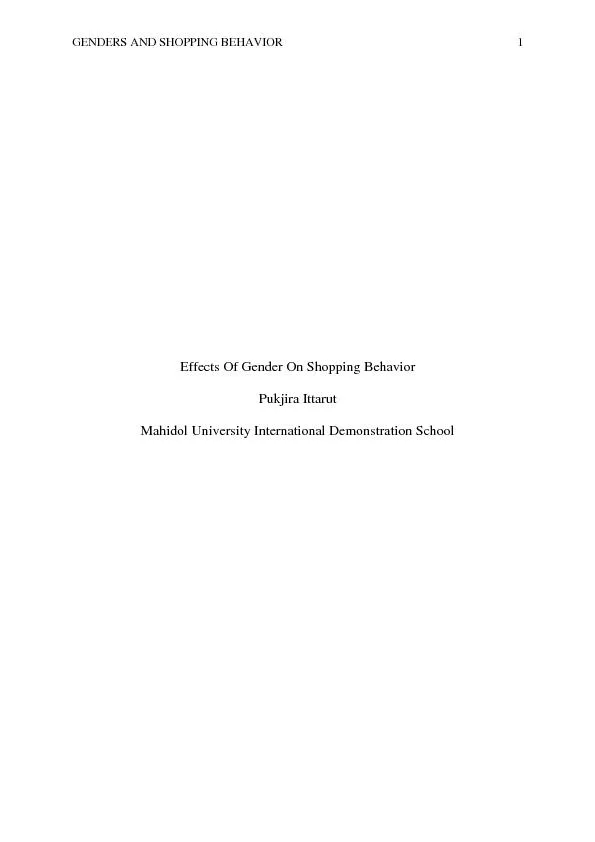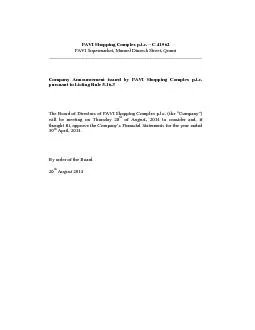PDF-GENDERS AND SHOPPING BEHAVIOR
Author : tawny-fly | Published Date : 2016-08-04
1 Effects Of Gender On Shopping Behavior Pukjira Ittarut Mahidol University International Demonstration School GENDERS AND SHOPPING BEHAVIOR 2 Abstract This study
Presentation Embed Code
Download Presentation
Download Presentation The PPT/PDF document "GENDERS AND SHOPPING BEHAVIOR" is the property of its rightful owner. Permission is granted to download and print the materials on this website for personal, non-commercial use only, and to display it on your personal computer provided you do not modify the materials and that you retain all copyright notices contained in the materials. By downloading content from our website, you accept the terms of this agreement.
GENDERS AND SHOPPING BEHAVIOR: Transcript
1 Effects Of Gender On Shopping Behavior Pukjira Ittarut Mahidol University International Demonstration School GENDERS AND SHOPPING BEHAVIOR 2 Abstract This study document that men and women show dif. Genotypes, Phenotypes and Aristotle. .. (32 slides). c. reatively compiled by dr. . m. ichael. . f. arnworth. An introduction to the law of the excluded middle…. Aristotle had three basic laws of thought. Radana . Bořilová. VY_32_INOVACE_085. ZŠ Jenišovice. SHOPPING. baker. pekař. butcher. řezník. florist. květinářství. chemist. lékárna,drogerie. greengrocer. ovoce zelenina. nawsagent. trafika. Because . when you arrive as a tourist at any city . in . the world, the first thing you will do is to roam around on its streets looking for things that you don’t see in your hometown, and buying stuff to take with you as a souvenir.. Gina Shine. Katie Walker. Stores. We both like Colorado mills. We like Wal-mart, Dress Barn, Forever 21, Aeropostle, Old-navy, American Eagle, Hollister, Target, K-mart, Best buy, Rue 21.. What we like to purchase. By Lillian Moore. Witch rides off. Upon her broom. Finds a space. To park it.. Takes a shiny shopping cart. Into the supermarket.. Smacks her lips and reads. The list of thing she needs:. 'Six bats' wings. By . Dishant Soni. Shopping Centers. Group of retail and other commercial establishments that are planned, developed, owned, and managed as a single property. Advantages of Shopping Malls. Many types of stores within one location. To sell online. You need two things: hardware and software. hardware means technological infrastructure. Domain Name. Website. Database. Shopping cart. SSL. Software means operational aspects. Strategy for online business. Marti Weiner, M.S., CCC-SLP, BCBA. November 12, 2015. My name is Marti Weiner. I am a licensed speech language pathologist in Kansas and Missouri, hold a Certificate of Clinical Competence in Speech and Language Pathology, and am a Board Certified Behavior Analyst. I have no relevant financial relationships within the products or services described, reviewed, evaluated or compared in this presentation. I have a nonfinancial personal relationship, in that I have a son with autism. . Shopping Cart Abandonment Team. Kim Corbin- Property Maintenance Department. Jennifer Herman- Assistant City Attorney. Gene Prevatt- Sanitation Bureau . Chief. Jonas Subar- SCMPD Management . Analyst. Millennials are... Savvy Shoppers. 37% of millennial loves shopping and 48% enjoy it. . 50% of millennial men and 70% of millennial women consider shopping a form of entertainment and something to share with friends and family.. Internet Shopping in Korea Kristen O’Brien Why should I bother shopping on the internet in Korea? It’s cheaper than in stores. Shipping is usually 1-2 days You can get coupons (even for just registering) From a comprehensive perspective, the shopping mall market remains relatively strong because consumer spending/retail sales increased 3.4% YOY for the first half of 2019. Any increase of more than 3.0% is generally a sign the overall economy is strong.. p . l . c . – C 41962 PAVI Supermarket, Manuel Dimech Street, Qormi _____________________________________________________________ Company Announcement issued by PAVI Shopping Complex p.l.c. pursua 549 to a detrimental psychiatric problem known as compulsive buying behavior (Black et al. , 2012). Compulsive buying behavior (CBB) is defin ed by repetitive and uncontrollable buying that becomes
Download Document
Here is the link to download the presentation.
"GENDERS AND SHOPPING BEHAVIOR"The content belongs to its owner. You may download and print it for personal use, without modification, and keep all copyright notices. By downloading, you agree to these terms.
Related Documents














